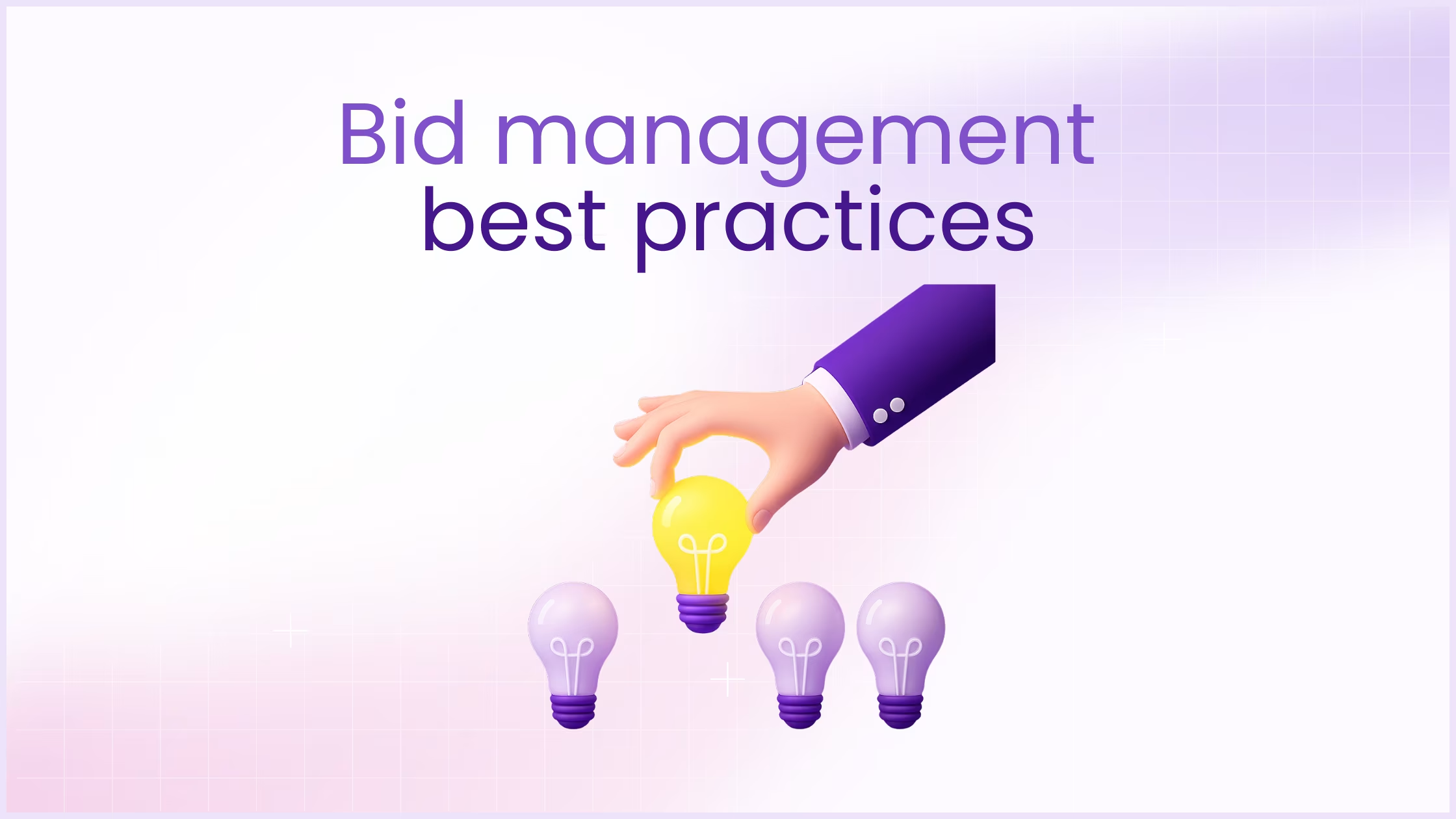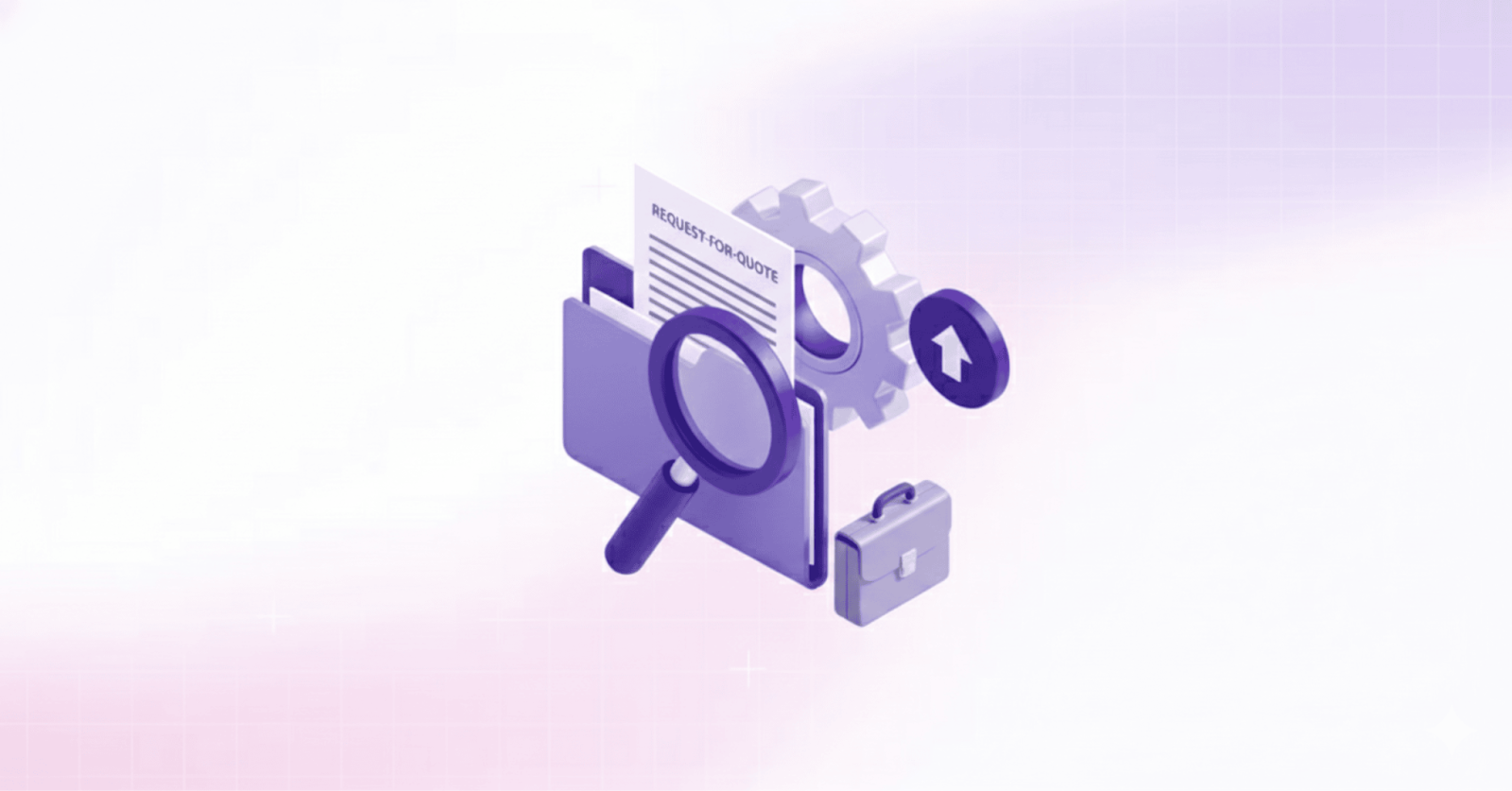There are two kinds of companies in 2025:
Those still wrestling with Word docs and late-night RFP scrambles, and those quietly winning contracts before their competitors even finish formatting page one.
What’s the difference?
Not luck. Not headcount. Just smarter systems.
Welcome to the world of bid software and bid management tools that don’t just manage proposals, they orchestrate wins.
In this blog, we’ll unpack what top-performing teams are doing differently this year. From streamlining workflows with the latest bid management platforms to building bulletproof review cycles, you’ll get a modern blueprint for competitive bidding, minus the chaos.
Ready to leave guesswork behind and bring structure, speed, and strategy into your bidding process?
Let’s begin.
Understanding the bid management process
Behind every contract won is a repeatable, teachable system. That system? Bid management.
In 2025, the bid process is no longer manual or siloed. It’s powered by intelligent bid management software that turns opportunity tracking, proposal creation, and submission into one connected, streamlined workflow.
1. Opportunity identification and tracking
Great bids don’t begin with an RFP; they begin with foresight.
Top bid management teams use tools and bid response platforms to track opportunities before they hit public portals. Whether it’s setting up alerts, maintaining a watchlist of renewal cycles, or leveraging relationship intel, this phase is about staying one step ahead.
When paired with the right bid software, this early visibility becomes a competitive advantage.
2. Making the bid/no-bid decision
Sometimes, the smartest bid is the one you don’t submit. Learning how to evaluate an RFP is the next step after tracking down opportunities.
In a fast-paced bidding environment, the right bid management software can help teams qualify opportunities with precision. By scoring RFPs against criteria like strategic fit, resource availability, and likelihood of success, you’re not guessing; you’re choosing wisely.
Modern bid management platforms automate this filtering process, giving you clarity in minutes, not hours. Here is a ready-to-use bid/no-bid decision-making playbook.
3. Planning and team coordination
Once you’re in, plan like a pro.
Bid management isn’t just about writing; it’s about organizing. From timelines and task assignment to stakeholder alignment, every moving part needs a home. A centralized bid management tool acts as mission control, ensuring the right people are working on the right pieces, in sync.
No more lost attachments or endless email chains, just one source of truth.
4. Proposal development and review
Here’s where the story gets written and rewritten.
Bid proposal software today does more than word processing. It powers collaboration, enforces consistency, and guides SMEs and writers with pre-approved content blocks. Review cycles are sharper when everyone knows what to look for: compliance, accuracy, tone, not just “general feedback.”
With the right bid management platform, quality control becomes a built-in feature, not a fire drill.
5. Submission and post-submission follow-up
You’ve written a great bid. Now make sure it lands perfectly.
Bid management software streamlines submission workflows, reducing last-minute formatting issues and upload errors. And after the send? Follow-ups matter. Whether it’s a thank-you note or a request for feedback, post-submission touchpoints keep you top of mind.
Smart teams also use bid response platforms to log wins, losses, and lessons, so the next bid is always better than the last.
Key roles in the bid process
Bid success isn’t a solo sport. It’s a relay where each role hands off smoothly to the next.
Understanding who does what is critical to optimizing your bid management process.
Bid manager vs proposal manager
Who is a bid manager? Think of the bid manager as the director. They orchestrate the whole production, from strategy to submission. The proposal manager, meanwhile, owns the script, driving the content, tone, and compliance of the final deliverable.
Your bid management tool should reflect this split: strategic oversight for bid managers and granular content control for proposal managers.
Role of SMEs, sales, and executives
Subject Matter Experts (SMEs) translate technical know-how into compelling content. They make the proposal credible. But they’re often time-strapped, so your bid software must make contributing easy.
Sales teams bring the voice of the customer. They know the buying signals and pain points and help shape the proposal accordingly.
Executives bring strategic alignment and approvals. They keep the bid directionally correct and authorize resources where needed.
Importance of content and graphic designers
Design isn’t decoration, it’s navigation.
A great bid proposal software should support templates, layouts, and visual content that enhance readability. Graphic designers ensure complex ideas are presented clearly and persuasively.
Whether it’s a flowchart, timeline, or infographic, good design keeps evaluators engaged and guides them to your strengths.
Top 10 bid management best practices for 2025
If your bid process still feels like controlled chaos, it’s time to upgrade your approach. These 10 best practices are what winning teams are doing today, with the help of modern bid management platforms.
1. Qualify opportunities ruthlessly
Saying yes to everything burns out teams and budgets. Use a bid management tool to evaluate fit, feasibility, and likelihood of winning before writing a single word.
Walk away from low-fit bids. It’s not a loss; it’s resource protection.
2. Assemble and enable the right team
Great bids come from well-structured teams. Whether remote or in-person, your bid management software should clearly define roles and responsibilities, helping everyone work from the same playbook.
Accountability, not ambiguity, is the goal.
3. Automate and centralize workflows
Email threads and spreadsheets? They’ve had their time.
A centralized bid management platform houses everything: timelines, content, version history, approvals, and updates. Automation reduces friction and saves time where it matters most.
4. Build and maintain your knowledge base
Your team shouldn’t rewrite the same content for every RFP.
Modern bid proposal software includes content libraries that store reusable responses, updated FAQs, and compliance language. Tag, organize, and search with ease. Future-you will thank you.
5. Embrace AI-driven bidding
AI in bid management isn’t just hype; it’s happening.
From automated content suggestions to predictive scoring and language optimization, AI helps your team focus on strategy, not sentence structure. Choose a bid software that’s AI-ready and built to scale with innovation.
6. Align your proposal with customer needs
Every bid should feel like it was written just for them.
Use insights from sales and past interactions to tailor your messaging. With a flexible bid management tool, you can swap out boilerplate content with client-specific language that hits the mark.
7. Prioritize compliance and formatting
A missed checkbox can disqualify an otherwise perfect bid.
Your bid management platform should flag gaps in compliance, enforce formatting rules, and run pre-submission checks. Precision is the baseline in competitive bidding.
8. Design for readability
Design isn’t optional. It’s a strategic lever.
Leverage graphic design early. A good bid response platform allows seamless integration of visuals, templates, and design assets that tell your story, without clutter.
9. Run smarter review cycles
Vague review feedback? It’s a waste of time.
Assign focus areas. Use comment threads within your bid proposal software so reviewers don’t work in silos. And keep reviews scheduled not ad hoc.
10. Always debrief and improve
Every bid is an insight engine.
Whether you win or not, run structured debriefs. Store feedback in your bid software. Track patterns. Refine your approach. Smart teams treat every proposal like a training ground for the next one.
How SiftHub makes bid management easier
With the right strategy, team, and bid management tools, you can build a proposal engine that consistently delivers, without burning out your people.
Here’s your new checklist:
✅ Qualify better
✅ Collaborate smarter
✅ Design beautifully
✅ Submit with confidence
✅ Learn from every bid
And most importantly, use the right bid management software, not just a duct-taped stack of documents and spreadsheets.
Whether you’re upgrading your current toolset or starting fresh, investing in a modern bid management platform or bid proposal software is no longer optional.
Your next contract could be one click (and one smart process) away.
SiftHub helps proposal teams skip the manual grunt work and focus on strategy, storytelling, and winning.
Here’s how:
- Auto-analyze complex RFPs to highlight key requirements, risks, and solution fit
- Autofill hundreds of answers using past wins and connected content libraries
- Get first drafts in minutes, not hours directly in Docs, Excel, or vendor portals
- Enable seamless teamwork with built-in collaboration, approvals, and progress tracking
If you’re ready to double your RFP capacity and improve your win rate, see how SiftHub works.
FAQs around bid management
How should we evaluate bid management software?
Without the right tools, even the best team will struggle.
Here’s what to look for when evaluating bid management software in 2025.
Overview of bid management tools
There are 2 broad types:
- Point solutions: Focused tools for specific tasks like answering RFPs or managing pricing.
- Bid management platforms: All-in-one systems that handle everything from opportunity capture to post-bid analysis.
Look for features like:
- Document import/export
- Project timelines
- Role-based permissions
- Content library integration
- Win-rate tracking
Construction teams may favor tools tailored for scopes, partners, and contracts. Marketing and sales teams might need bid response platforms built around fast collaboration.
Choose what fits your flow.
2. How is AI changing the bid process?
AI has evolved from “nice to have” to “must-have.”
Teams using AI-powered bid management tools are drafting faster, personalizing better, and reviewing smarter. Whether it’s suggesting the best past answer or flagging compliance risks, AI amplifies human expertise.
It’s not replacing your team; it’s removing the grunt work.
3. Which is the best bid management platform?
With the stakes and the speed of competitive bidding at an all-time high, the right bid management tool can be the difference between missed deadlines and repeat wins.
SiftHub stands out as the best bid management platform, helping sales, proposal, and capture teams streamline RFP responses, manage bids more efficiently, and boost win rates:
It’s best for: Sales and proposal teams looking to automate complex RFPs, bids, and questionnaires with AI.
SiftHub’s strengths:
- Instantly analyzes RFPs and recommends bid/no-bid decisions
- Autofills complex responses using past wins and connected knowledge sources
- AI-powered agent handles hundreds of questions in minutes across tools like Docs, Excel, and vendor portals
Why it’s great:
SiftHub doesn’t just manage your bid process; it accelerates it. By automating repetitive tasks and surfacing winning content, it frees up your team to focus on strategy, storytelling, and what matters: winning.









.avif)
